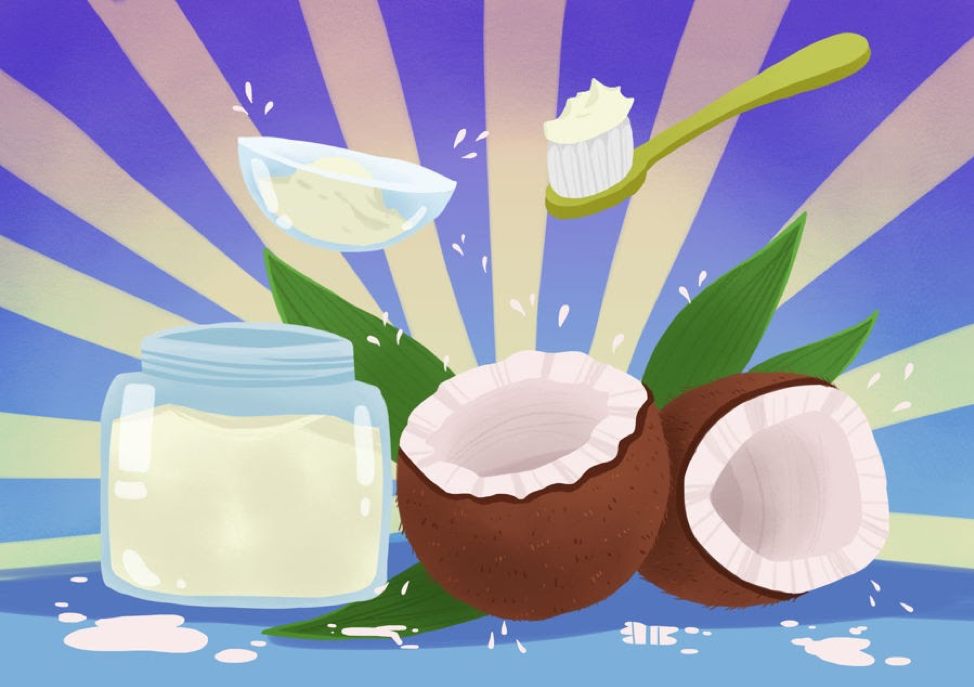
What is Oil Pulling?
Oil pulling is an ancient Ayurvedic technique which dates back over 5000 years where oil is swished in the mouth to cleanse and remove toxins by “pulling” or drawing them out.
Oil pulling has the potential to benefit many ailments from
- gum disease
- halitosis
- asthma
- constipation
- migraine
- arthritis
- dental caries / cavities
- acne and more.
Oil pulling isn’t just some ancient practice but rather it has been backed by good science.
Why should I try Oil Pulling?
Fast food, fried food, processed and pre-made frozen food are difficult to digest for our body and can therefore stick to the intestine and form toxins over time (These toxic byproducts are often referred to as “ama” in Ayurveda). These toxic waste products are then transported to all the organs through the bloodstream which can lead to the accumulation of toxic waste and contribute to the pathophysiology of a variety of diseases, according to Ayurveda.
How does the oil pulling work you ask?
Toxins (harmful microorganisms) in our body are covered in lipids (fat), so when you swish oil in your mouth it acts as a “magnet” and attracts all the toxins to itself.
What the oil does is break the attachment of toxins and toxic “biofilm” to your mouth, then the toxins end up in the oil. This action lowers the concentration of bacterial colonies, “pulling” them into the clean oil. By the end of the oil pulling the clean oil is full of bacteria and other toxins, so this is why we spit it out – we don’t want those bacteria! More about How to oil pull below!
Oil used in oil pulling often has antimicrobial properties of its own, read on below for more information about what oil to use for oil pulling.
Oil pulling is also a way to engage the vagus nerve, which activates the parasympathetic nervous system (PNS). The PNS is also known as the “rest and digest” part of the nervous system meaning it helps relax the muscles and the body.
Fun Fact: In Ayurveda the human tongue is considered to be a reflection of the health of the stomach, small intestine, colon, heart, lungs, and other organs in the body, so the oil pulling is theorized to be effective in getting toxins out of the entire body.
*If you have ever visited a Traditional Chinese Medicine Practitioner / Acupuncturist / Ayurvedic Practitioner / Functional Medicine Practitioner you may often wonder why they ask you to stick out your tongue for them to examine it – this is why!
What oil to use for oil pulling: oil choices & their benefits
Sesame oil has been traditionally used for thousands of years. Sesame oil contains compounds with detoxification, antioxidant, and antibiotic actions.
In modern times many have opted for other oils such as sunflower oil, olive oil, and coconut oil.
Coconut oil has lauric acid which is high in antimicrobial agents which makes it antiviral, anti-bacterial and anti-inflammatory. Some have stated that the taste of coconut oil is more tolerable than other oils, so if you do not have a sensitivity/allergy to coconut, this may be a good one to try!
When it comes to oil pulling, the type of oil you choose can significantly impact your experience and results. While traditional Ayurvedic practice primarily used sesame oil, modern practitioners have expanded to include several alternatives.
Here’s an in-depth look at the most popular oils for oil pulling and their unique benefits:
Sesame Oil
The Traditional Ayurvedic Choice
- Traditionally used in Ayurveda for thousands of years
- Rich in powerful antioxidants including sesamol, sesamin, and sesamolin
- High concentration of Vitamin E and polyunsaturated fatty acids
- Contains natural antibacterial properties proven effective against cavity-causing bacteria
- Studies support its effectiveness in preventing dental cavities and gingivitis
- Has a distinct nutty flavor that some people find strong
- Considered warming in Ayurvedic medicine, making it excellent for Vata constitutions
- Helps inhibit harmful cholesterol absorption in the liver
Coconut Oil
The Modern Favorite
- Contains lauric acid, a medium-chain triglyceride (MCT) with powerful antimicrobial properties
- Effective against bacteria that cause tooth decay
- Antiviral, antibacterial, and anti-inflammatory properties
- Often preferred for its milder, more pleasant taste compared to other oils
- May decrease plaque buildup, reducing risk of gum disease
- Solid at room temperature but melts quickly in the mouth
- Cooling properties make it particularly suitable for Pitta constitutions
- Excellent choice for beginners due to its palatability
Olive Oil
The Mediterranean Option
- Rich in anti-inflammatory compounds that protect against various diseases
- Contains natural antibacterial properties, particularly effective against Helicobacter pylori
- Liquid at room temperature, making it convenient to use
- Rich in polyphenols with protective antioxidant effects
- Milder flavor than sesame oil but stronger than coconut oil
- Particularly good for heart health while providing oral benefits
- Extra virgin varieties offer the highest concentration of beneficial compounds
Sunflower Oil
The Light Alternative
- Mild, neutral flavor makes it an accessible option for beginners
- High in vitamin E, which supports gum health and reduces inflammation
- Lighter consistency compared to other oils, making it easier to swish
- Contains linoleic acid, which helps maintain cell membrane integrity
- Budget-friendly and widely available
- Particularly beneficial for those with nut or coconut allergies
- Balancing properties make it suitable for most constitution types
Almond Oil
The Nutrient-Rich Option
- Sweet, mild flavor that most people find pleasant
- Rich in vitamin E, providing antioxidant protection for gum tissue
- Contains zinc, which supports immune function in the oral cavity
- Anti-inflammatory properties help reduce gum inflammation
- Supports healthy cell regeneration for oral tissues
- Light texture that’s easy to work with
- Particularly beneficial for dry mouth conditions
- Nourishing properties make it ideal for sensitive gums
Choosing the Right Oil
When selecting an oil for pulling, consider these factors:
- Taste preference: Choose an oil with a flavor you can tolerate for 15-20 minutes
- Allergies: Always avoid oils that may trigger allergic reactions
- Therapeutic goals: Different oils offer varying benefits for specific conditions
- Quality: Opt for organic, cold-pressed, unrefined oils for maximum benefits
- Ayurvedic constitution: Your dosha (Vata, Pitta, Kapha) may influence which oil works best for you
- Seasonal considerations: Some oils may be more appropriate in different seasons
Remember that the effectiveness of oil pulling comes primarily from the mechanical action of swishing and the lipid-attracting properties of oils in general.
Regardless of which oil you choose, consistency in your practice is key to experiencing the full benefits of oil pulling for your oral and overall health.

How To “Oil Pull”
Oil pulling is most effective when it’s done after waking up on an empty stomach.
Step 1: Take 1-2 teaspoons of oil and put it in your mouth. The amount of oil you use at first depends on how much you can hold and the size of your mouth. Ideally, you want to use 1 tablespoon.
Step 2: Start swishing the oil around the mouth and keep doing this for about 5-20 minutes. Make sure the oil is being pulled through the teeth and gums. Just like as if you were using mouthwash.
- Note: Be very careful and DO NOT swallow the oil since it will contain toxins and bacteria from the oil pulling.
Step 3: Spit the oil out in a plastic bag, paper towel or something disposable. NEVER spit the oil down the drain as it could clog your drain.
Step 4: Gargle with warm salt water to remove any oil residue from your mouth. You can also use tongue cleaner to scrape any excess residue off of your tongue.
Step 5: Brush and floss your teeth like you would normally to ensure all the bacterial residue is removed from the teeth.
How Do I Know if I Am Doing it Right?
The ideal duration for oil pulling is 20 minutes, but this can be gradually built up over time. This length of time allows the oil to fully bind with bacteria and toxins while giving your saliva’s enzymes sufficient time to break down plaque.
Do not exceed 20 minutes as it is theorized that the toxins can be reabsorbed by your body. So, start with 5 minutes every morning and then gradually increase it to 20 minutes.
Duration Guide Based on Experience Level
- Beginners (First 1-2 Weeks): Start with 5 minutes daily to build jaw strength and become accustomed to the sensation
- Intermediate (Weeks 3-4): Increase to 10-15 minutes, focusing on technique improvement
- Advanced (Week 5+): Full 20 minutes for maximum benefits
How to Verify Effective Duration
When you spit the oil out it should look white and milky. This means that the toxins and bacteria have been pulled out. If oil looks clear or yellowish, then you haven’t oil pulled for long enough.
Tips for Building Duration
- Use a timer and distract yourself with other morning activities
- Begin with a smaller amount of oil (1 teaspoon) until comfortable
- Prioritize consistency over duration—5 minutes daily is better than 20 minutes occasionally
Remember that oil pulling complements but doesn’t replace regular dental care. Do not skip daily brushing and flossing, and tongue cleaning. Oil pulling is a practice that you can add to your oral hygiene.
Benefits of Oil Pulling
Our oral cavity is covered with biofilm which contains about 700 different microorganism species. Oil pulling has been effective in reducing 20% of total microbial count in the mouth. The reductions are mostly of the C. albicans, Lactobacilli and S. mutans varieties that can cause dental caries when the pH drops below a certain level in the oral cavity.
Oil pulling has also been helpful for plaque-induced gingivitis, halitosis (commonly known as bad breath), oral candidiasis, yellowed teeth, plaque and tartar build up, and even SIBO, amongst other things.

Important note: Do not skip daily brushing and flossing and tongue cleaning. Oil pulling is a practice that you can add to your oral hygiene. It shouldn’t replace any of your existing routines and yearly dental check-up and your dentist’s recommendations.
If you found this article insightful then give this practice a try and let us know how helpful it was. You have nothing to lose. It is an easy and cost effective way to improve your oral hygiene with many added benefits, one of them being a bright and shiny smile.
References
- Oil pulling for maintaining oral hygiene – A review
- Oil pulling and importance of traditional medicine in oral health maintenance
Tell us what you think.
2 Comments
Leave A Comment
Dr. Minal Vazirani

CONTACT INFORMATION
844.543.2537 (1.844.5HEALER)
info@ihwa-nj.com
OFFICE LOCATIONS
112 Town Center Drive Suite 201
Warren, NJ 07059
200 South Orange Ave Suite 107
Livingston, NJ 07039
Dr. V. is a warm and compassionate individual. She is well versed in several forms of medicine. That is why I like her because she can see things from different angles. She is very wise for her years.
Always Positive!! Integrative Medicine has saved me! Thank You Dr. Vazirani!!
Dr. Vazirani is very pleasant, knowledgeable and always has the interest of the patient. I am very happy to be under her care and would recommend her to all my friends
Are you looking for a Triple Board Certified Doctor who gets Integrative, Functional, & Ayurvedic Medicine in NJ?
Message us or complete our intake form to get started with Dr. Vazirani.




[…] we recommend oil pulling, followed by brushing your teeth and rinsing your mouth. Now you are ready to tongue […]
I have to say I am amazed with how well oil pulling is working for me. I’ve been having trouble my whole life with other oral hygiene products, like expensive rinses and toothpastes and some of those made things worse!
I started oil pulling a few months ago and the first thing I noticed is how well it works on plaque and is a great pre-cleaning before flossing. I’m having a much easier time with other cleaning now and I’m very glad I learned about it.
p.s., not sure how this aligns with Ayurveda but I’m sometimes doing a mini-pull in the middle of the day after eating when the food is extra sticky on my teeth.